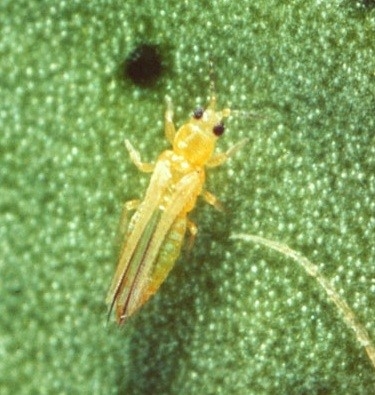Norman Knows Thrips
By Norman Smith UCCE Master Gardener
If you have citrus trees, you've probably seen damage from this bug, but not the bug itself. This is damage by citrus thrips, a very small insect that likes to hide inside protective places such as inside orange blossoms and young flushes of leaf growth. Careful searching can expose them, but most have no idea this insect is even there until it's too late. The overwintering generation becomes active during the bloom period for citrus in late spring. They confine their activity to the blossoms, feeding on the small developing fruit inside the blossom, mostly around the stem. They have rasping sucking mouthparts, scraping the surface of soft, developing fruit and leaves and then sucking up the sap as it leaks out.
Unfortunately, this scars the young fruit and leaves and as they grow, this scarring can cause a cosmetic defect to the fruit and deform some mature leaves. If you are a commercial orange grower, cosmetic damage to the fruit is not a good thing. It will likely lower the grade and ultimately the price for his fruit. So commercial growers are likely to treat for citrus thrips to avoid this damage. But you, as home growers of citrus, do not have to worry about scarred fruit. The scarring does not affect the taste or size of the orange. In fact, the scarred fruit may be sweeter. Since the majority of damage occurs on the southwest side of the tree, the warm side, this is likely true as these fruits will ripen sooner and be sweeter when picked.
As far as the deformed leaves are concerned, they may be unsightly but the majority of leaves on the tree are not deformed and the few that are will not affect the ability of the tree to set, size and ripen the oranges. The reason for this is that when the tree blooms, a major flush of new leaves also emerges, but since the thrips are inside the blossoms, these leaves are not damaged and develop normally. It is only the newer growth that occurs later in the season that thrips will infest and damage. They will enter and feed on the newly expanding growth, hiding between the tiny developing leaves and damaging them. These leaves will be able to produce food for the fruit, despite their unsightly appearance; the branch they are on will produce normal blossoms and leaves the following year, and after a year or two, the deformed leaves will fall off the tree. It is for this reason, that we do not recommend that backyard growers of citrus treat for this insect. The damage is merely cosmetic, and the tree will continue to grow normally, and set and produce normal fruit.
